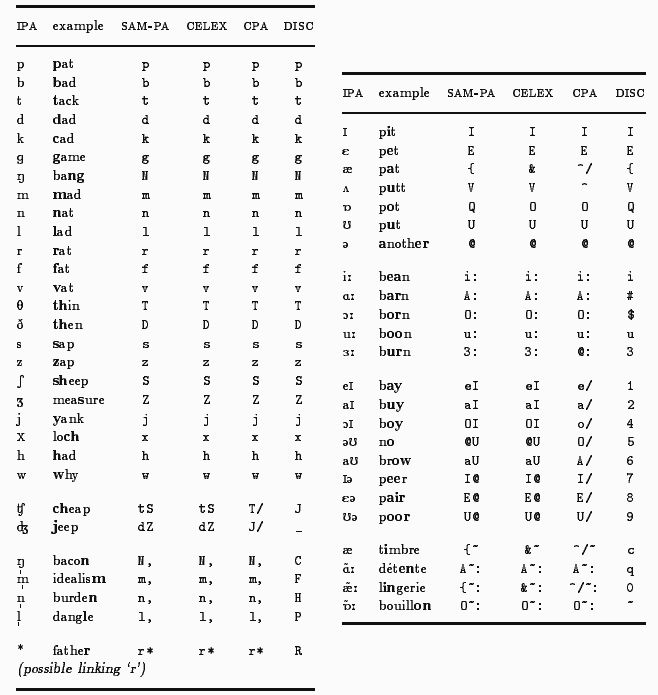hellog〜英語史ブログ / 2013-04-06
01 02 03 04 05 06 07 08 09 10 11 12 13 14 15 16 17 18 19 20 21 22 23 24 25 26 27 28 29 30
2013-04-06 Sat
■ #1440. 音節頻度ランキング [syllable][corpus][lexicon][phonetics][frequency][statistics]
「#1424. CELEX2」 ([2013-03-21-1]) で紹介した巨大データベースで何かしてみようと考え,Version 2 で新たに加えられた音節頻度 (English Frequency, Syllables) のサブデータベースにより,現代英語で最も多い音節タイプのランキングを得た.
これは,CELEX2 のもとになっているコーパス全体のうち,7.26%を構成する約130万語の話し言葉サブコーパスから引き出された音節頻度であり,タイプ頻度ではなくトークン頻度によるものである.つまり,話し言葉におけるある単語の頻度が高ければ,その分,その単語に含まれる音節タイプの頻度も高くなるということである.例えば,of を構成する "Ov" (= /ɒv/) と表現される音節は,第4位の頻度である.なお,強勢の有無は考慮せずに頻度を数えている.
以下のリストに挙げる音素表記は,IPA ではなく CELEX 仕様の独特の表記なので,先に対応表を挙げておこう.

では,以下にランキング表でトップ50位までを掲載する.高頻度の単音節語の音節タイプがそのまま上位に反映されていて,あまりおもしろい表ではないが,何かの役に立つときもあるかもしれない.
| Rank | Syllable | Frequency |
|---|---|---|
| 1 | eI | 72971 |
| 2 | Di: | 60967 |
| 3 | tu: | 31446 |
| 4 | Ov | 30108 |
| 5 | In | 29906 |
| 6 | &nd | 28709 |
| 7 | aI | 23822 |
| 8 | lI | 19728 |
| 9 | @ | 19566 |
| 10 | rI | 14356 |
| 11 | ju: | 12598 |
| 12 | dI | 12465 |
| 13 | D&t | 12118 |
| 14 | It | 11504 |
| 15 | wOz | 10834 |
| 16 | fO:r* | 9778 |
| 17 | Iz | 9517 |
| 18 | tI | 9161 |
| 19 | fO | 9042 |
| 20 | Sn, | 8969 |
| 21 | hi: | 8928 |
| 22 | r@n | 8638 |
| 23 | bi: | 8505 |
| 24 | bI | 7936 |
| 25 | nI | 7068 |
| 26 | wID | 7046 |
| 27 | On | 7030 |
| 28 | &z | 6919 |
| 29 | O:l | 6569 |
| 30 | h&d | 6240 |
| 31 | E | 6165 |
| 32 | bl, | 6021 |
| 33 | sI | 5836 |
| 34 | @U | 5824 |
| 35 | t@r* | 5687 |
| 36 | &t | 5652 |
| 37 | hIz | 5564 |
| 38 | bVt | 5416 |
| 39 | mI | 5397 |
| 40 | s@ | 5391 |
| 41 | nOt | 5357 |
| 42 | D@r* | 5339 |
| 43 | I | 5283 |
| 44 | tId | 5259 |
| 45 | DeI | 5162 |
| 46 | IN | 5063 |
| 47 | t@ | 5053 |
| 48 | s@U | 4974 |
| 49 | baI | 4894 |
| 50 | h&v | 4769 |
全ランキング表を見たい方は,タブ区切り形式で Syllable Frequency Rank Table by CELEX2 を参照.ブラウザ上で閲覧したい方は,こちらからどうぞ.全体としては11492の異なる音節タイプが登録されており,頻度が1以上のものは7934タイプある.「#1023. 日本語の拍の種類と数」 ([2012-02-14-1]) の最後で,英語の音節タイプが日本語に比べて驚くほど多種多様であることに触れたが,この数をみれば納得できるだろう.関連して,syllable の各記事を参照.
なお,CELEX2 のマニュアルには以下の但し書きが記されていたので,再掲しておく.
Please note that the English corpus used by CELEX for deriving these frequencies contains only 7.3% spoken material. This means there is a rather tenuous relationship between the full frequency figures, which are based on written forms, and the syllable frequencies, which merely refer to phonemic conversions of these graphemic transcriptions. Of course it could be argued that frequencies of syllables, as lexical sub-units, are less liable to get skewed from differences in medium than full words, but it has to be taken into account that NO FIRM EVIDENCE ABOUT SPOKEN FREQUENCIES can be derived from these data.
2025 : 01 02 03 04 05 06 07 08 09 10 11 12
2024 : 01 02 03 04 05 06 07 08 09 10 11 12
2023 : 01 02 03 04 05 06 07 08 09 10 11 12
2022 : 01 02 03 04 05 06 07 08 09 10 11 12
2021 : 01 02 03 04 05 06 07 08 09 10 11 12
2020 : 01 02 03 04 05 06 07 08 09 10 11 12
2019 : 01 02 03 04 05 06 07 08 09 10 11 12
2018 : 01 02 03 04 05 06 07 08 09 10 11 12
2017 : 01 02 03 04 05 06 07 08 09 10 11 12
2016 : 01 02 03 04 05 06 07 08 09 10 11 12
2015 : 01 02 03 04 05 06 07 08 09 10 11 12
2014 : 01 02 03 04 05 06 07 08 09 10 11 12
2013 : 01 02 03 04 05 06 07 08 09 10 11 12
2012 : 01 02 03 04 05 06 07 08 09 10 11 12
2011 : 01 02 03 04 05 06 07 08 09 10 11 12
2010 : 01 02 03 04 05 06 07 08 09 10 11 12
2009 : 01 02 03 04 05 06 07 08 09 10 11 12
最終更新時間: 2025-11-29 10:28
Powered by WinChalow1.0rc4 based on chalow